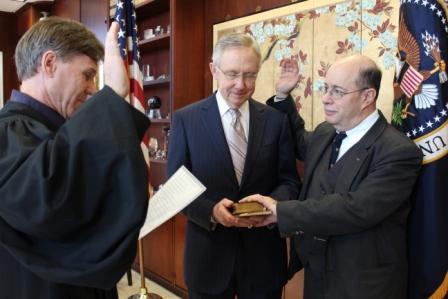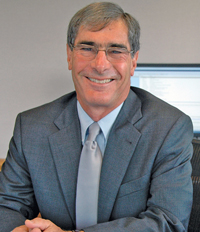In 2010, the Supreme Court decided STOP THE BEACH RENOURISHMENT. v. FLA. DEPT. OF ENV. PROT., 130 S. Ct. 2592 (2011). [Opinion] [Oral Argument via OYEZ]. This opinion raises an interesting academic issue with respect to patent law. Can the federal judiciary unfairly take a patent right in violation of the Takings Clause of the Fifth Amendment? According to Justice Scalia’s plurality opinion (on behalf of himself, C.J. Roberts, and Justices Thomas and Alito), it would appear one might make such an argument. Justice Scalia writes, with respect to taking by a state court:
In sum, the Takings Clause bars the State from taking private property without paying for it, no matter which branch is the instrument of the taking. To be sure, the manner of state action may matter: Condemnation by eminent domain, for example, is always a taking, while a legislative, executive, or judicial restriction of property use may or may not be, depending on its nature and extent. But the particular state actor is irrelevant. If a legislature or a court declares that what was once an established right of private property no longer exists, it has taken that property, no less than if the State had physically appropriated it or destroyed its value by regulation. “[A] State, by ipse dixit, may not transform private property into public property without compensation.” Ibid.
Justice Scalia gave as one example, the State of Florida ipse dixit recharacterizing the principal funds of an account as “public” money when it was actually private money:
Webb’s Fabulous Pharmacies, supra, is even closer in point. There the purchaser of an insolvent corporation had interpleaded the corporation’s creditors, placing the purchase price in an interest-bearing account in the registry of the Circuit Court of Seminole County, to be distributed in satisfaction of claims approved by a receiver. The Florida Supreme Court construed an applicable statute to mean that the interest on the account belonged to the county, because the account was “considered ‘public money,'” Beckwith v. Webb’s Fabulous Pharmacies, 374 So.2d 951, 952-953 (1979) (per curiam). We held this to be a taking. We noted that “[t]he usual and general rule is that any interest on an interpleaded and deposited fund follows the principal and is to be allocated to those who are ultimately to be the owners of that principal,” 449 U.S., at 162, 101 S.Ct. 446. “Neither the Florida Legislature by statute, nor the Florida courts by judicial decree,” we said, “may accomplish the result the county seeks simply by recharacterizing the principal as ‘public money.'” Id., at 164, 101 S.Ct. 446.
So, this raises an interesting issue with respect to patent rights. If a court wrongly recharacterizes a patent right so as to effectively dedicate it to the public, has the court executed a judicial taking? As an example, did the court in In re Abele, 684 F.2d 902 (1982) execute a judicial taking by recharacterizing an apparatus claim as a method claim and then invalidating the recharacterized claim as an abstract idea? In In re Abele, the CCPA effectively rewrote an apparatus claim as a method claim as shown below:
| Original Claim 7 |
Recharacterized claim 7 |
| 7. Apparatus for displaying data values representative of values at data points in a two dimensional field comprising: |
7R. A method Apparatus for displaying data values representative of values at data points in a two dimensional field comprising: |
| means for calculating the differences between the local values at each data point and the average value at data points in a limited region of said field surrounding each said data point, and |
means for calculating the differences between the local values at each data point and the average value at data points in a limited region of said field surrounding each said data point, and |
| means for displaying the value of said differences as signed gray scale values at points in a picture which correspond to said data points. |
means for displaying the value of said differences as signed gray scale values at points in a picture which correspond to said data points. |
The CCPA said in In re Abele:
Appellants do not argue and, in any event, we see no basis for treating their apparatus claims differently from their method claims.
If the functionally-defined disclosed means and their equivalents are so broad that they encompass any and every means for performing the recited functions, the apparatus claim is an attempt to exalt form over substance since the claim is really to the method or series of functions itself. In computer-related inventions, the recited means often perform the function of “number crunching” (solving mathematical algorithms and making calculations). In such cases the burden must be placed on the applicant to demonstrate that the claims are truly drawn to specific apparatus distinct from other apparatus capable of performing the identical functions.If this burden has not been discharged, the apparatus claim will be treated as if it were drawn to the method or process which encompasses all of the claimed “means.” [In re Walter, 618 F.2d at 768, 205 USPQ at 408.]Thus, claim 7, the apparatus counterpart to claim 5, suffers the same defects as does claim 5.
Clearly, the court recharacterized the apparatus claim as a method claim. After doing so, the court’s subsequent analysis found the claim to be ineligible subject matter as a mathematical algorithm. Thus, one could argue that the recharacterized claim was taken from a private entity and it inured to the benefit of the public. (One can debate whether the invalidation of a patent claim is a conveyance to the public, since a patent right is a right to exclude others from practicing the claim rather than a right to be able to practice the claim – nevertheless, the public is less encumbered when a patent claim is invalidated.)
So, what about the CyberSource Corp. v. Retail Decisions, Inc. case? In that case, the panel recharacterized a claim directed to a physical article as a method claim. The panel effectively rewrote the article of manufacture claim as follows:
| Original Claim 2 |
Recharacterized Claim 2 |
| 2. A computer readable medium containing program instructions for detecting fraud in a credit card transaction between a consumer and a merchant over the Internet, wherein execution of the program instructions by one or more processors of a computer system causes the one or more processors to carry out the steps of: |
2R. A computer readable medium containing program instructions method for detecting fraud in a credit card transaction between a consumer and a merchant over the Internet, wherein execution of the program instructions by one or more processors of a computer system causes the one or more processors to carry out the steps of comprising: |
| a) obtaining credit card information relating to the transactions from the consumer; and |
a) obtaining credit card information relating to the transactions from the consumer; and |
| b) verifying the credit card information based upon values of plurality of parameters, in combination with information that identifies the consumer, and that may provide an indication whether the credit card transaction is fraudulent, |
b) verifying the credit card information based upon values of plurality of parameters, in combination with information that identifies the consumer, and that may provide an indication whether the credit card transaction is fraudulent, |
| wherein each value among the plurality of parameters is weighted in the verifying step according to an importance, as determined by the merchant, of that value to the credit card transaction, so as to provide the merchant with a quantifiable indication of whether the credit card transaction is fraudulent, |
wherein each value among the plurality of parameters is weighted in the verifying step according to an importance, as determined by the merchant, of that value to the credit card transaction, so as to provide the merchant with a quantifiable indication of whether the credit card transaction is fraudulent, |
| wherein execution of the program instructions by one or more processors of a computer system causes that one or more processors to carry out the further steps of; |
wherein execution of the program instructions by one or more processors of a computer system causes that one or more processors to carry out the further steps of; and further comprising |
| [a] obtaining information about other transactions that have utilized an Internet address that is identified with the credit card transaction; |
[a] obtaining information about other transactions that have utilized an Internet address that is identified with the credit card transaction; |
| [b] constructing a map of credit card numbers based upon the other transactions; and |
[b] constructing a map of credit card numbers based upon the other transactions; and |
| [c] utilizing the map of credit card numbers to determine if the credit card transaction is valid. |
[c] utilizing the map of credit card numbers to determine if the credit card transaction is valid. |
| |
|
Having effectively recharacterized the article of manufacture claim as a method claim and ignored the physical limitations in the claim that tied the claim to a physical object, the panel in CyberSource concluded that the claim covered a mental process and was thus patent ineligible. One could argue that this is another example of a taking of a private right (i.e., a taking of the patent right to the article of manufacture) and a transfer of that right to the public. (Again, it is open to debate whether destruction of a right to exclude is a transfer to the public – but the public is certainly less encumbered after the destruction of a patent right.)
This raises an interesting issue with respect to the petition for certiorari in CyberSource. If the petition for cert. is denied or never filed, could CyberSource later bring a judicial takings claim against the U.S. judiciary? Justice Scalia’s plurality opinion suggests that the remedy for a judicial taking is a restoration of the taken property back to the injured party. In this case, that would be restoration of the article of manufacture claim. Moreover, assuming that the statute of limitations for a judicial takings is six years, think what havoc a judicial takings policy would have if one could wait six years and then revive a patent right previously deemed invalid by a court.
Justice Scalia’s plurality opinion seems to suggest that any change in the law – not even a significant change in the law – by the judiciary that results in a property right being extinguished can result in a judicial taking. The next time you read a precedential opinion from the court or read the fiery opening lines of a dissenting opinion, consider whether a once valid patent right has been extinguished.
Personally, I think a judicial takings policy in the context of patent law is likely unworkable. But, it is an interesting subject to think/argue about.
For more on judicial takings and patent law see: S.L. Dogan and E.A. Young “Judicial Takings and Collateral Attack on State Court Property Decisions,” 6:1 Duke Journal of Constitutional Law and Policy 111, 130 (2011).


